“Something,” penned by the legendary George Harrison, stands as a testament to The Beatles’ unparalleled songwriting prowess. Released on the iconic “Abbey Road” album, this ballad is not just a song; it’s a masterclass in melody, chord progression, and heartfelt expression. Its enduring appeal is evident in its status as the second most covered Beatles song, with over 150 artists interpreting its magic. Rumored to be inspired by Harrison’s former wife, Patti Boyd, “Something” is a musical journey that every guitarist should embark on.
In this comprehensive guide, we’ll provide you with everything you need to learn to play “Something” on guitar. From detailed chord diagrams and tabs to an insightful music theory analysis, we’ll break down this masterpiece section by section. Whether you’re a beginner guitarist or looking to deepen your understanding of Beatles’ classics, this tutorial is for you. Get ready to explore the chords, the unforgettable guitar solo, and the underlying genius of “Something.”
“Something” Beatles Chords: Your Guide to Playing the Song
To truly capture the essence of “Something,” understanding its chord structure is crucial. The song features a rich and sophisticated chord progression that moves through different sections, creating its signature sound. Let’s begin by looking at the overall chord chart to get a feel for the song’s landscape before diving into the specifics of each section.
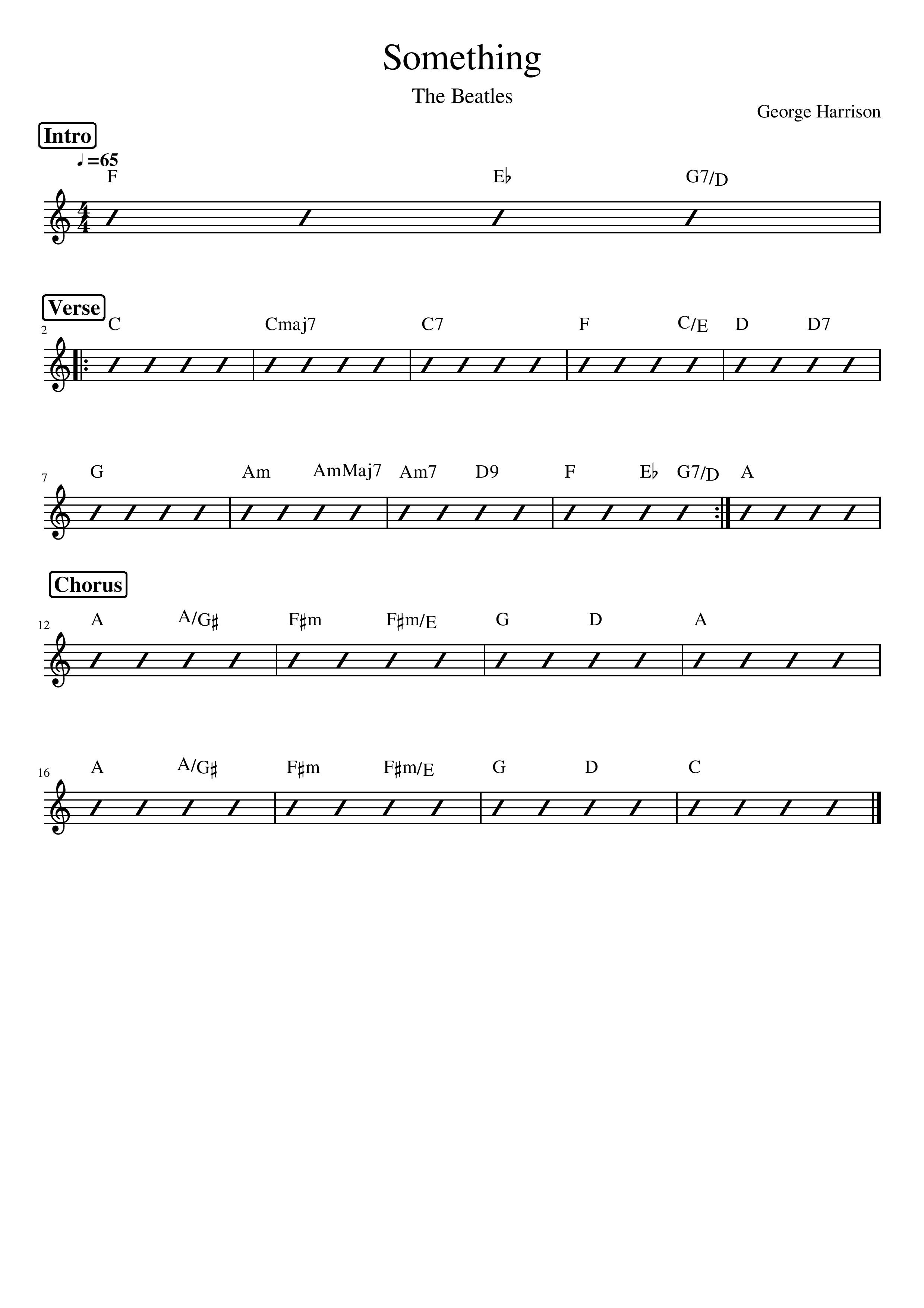 Full chord chart for "Something" by The Beatles
Full chord chart for "Something" by The Beatles
Now, let’s break down the chords section by section, starting with the intro, then moving to the verse and chorus. We’ll provide easy-to-follow chord diagrams to get you playing smoothly.
Intro Chords
The intro to “Something” is instantly recognizable and sets the tone for the entire song. These chords are not only beautiful but also relatively accessible for guitarists. The voicings suggested below are designed to minimize hand movement, making the transitions smoother and easier to play.
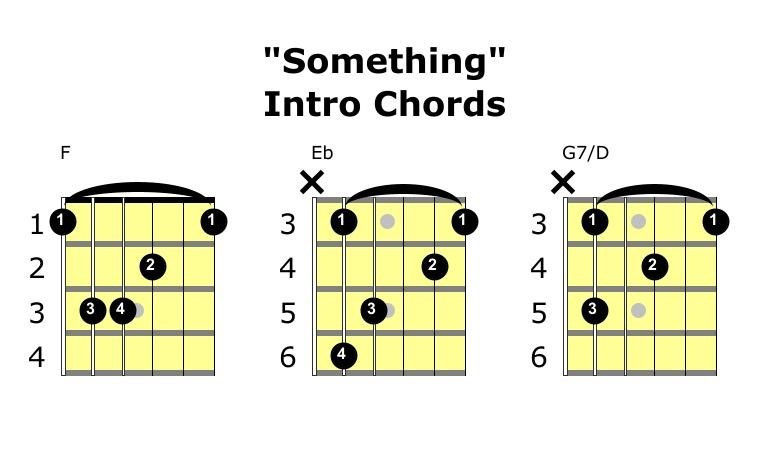 Guitar chord diagrams for the intro of "Something" by The Beatles
Guitar chord diagrams for the intro of "Something" by The Beatles
These intro chords create a melancholic and inviting atmosphere, drawing the listener into the song’s emotional core. Practice transitioning between F, Eb, and G7 to get the intro lick under your fingers.
Verse Chords
The verse chords of “Something” offer a warm and intimate feel. Open position voicings are particularly effective here, providing a rich sound and comfortable finger placement. These chords are fundamental to the song’s verses and are quite approachable for guitarists of all levels.
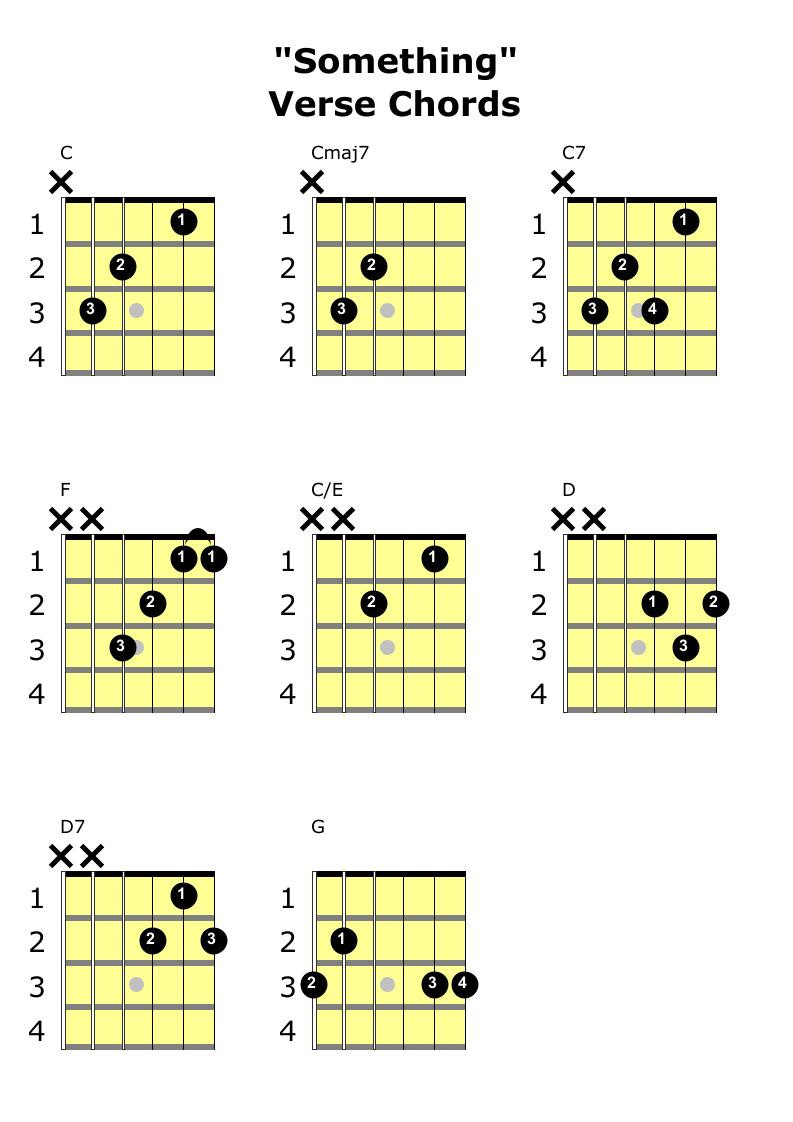 Guitar chord diagrams for the verse of "Something" by The Beatles
Guitar chord diagrams for the verse of "Something" by The Beatles
Notice the subtle variations within the verse chords, particularly the Am section. Here are further voicings for the Am chords in bar 8, offering options to suit your playing style.
For guitarists who are comfortable using their thumb to fret bass notes, these alternate voicings in the 5th fret can create a smoother transition to the D9 chord.
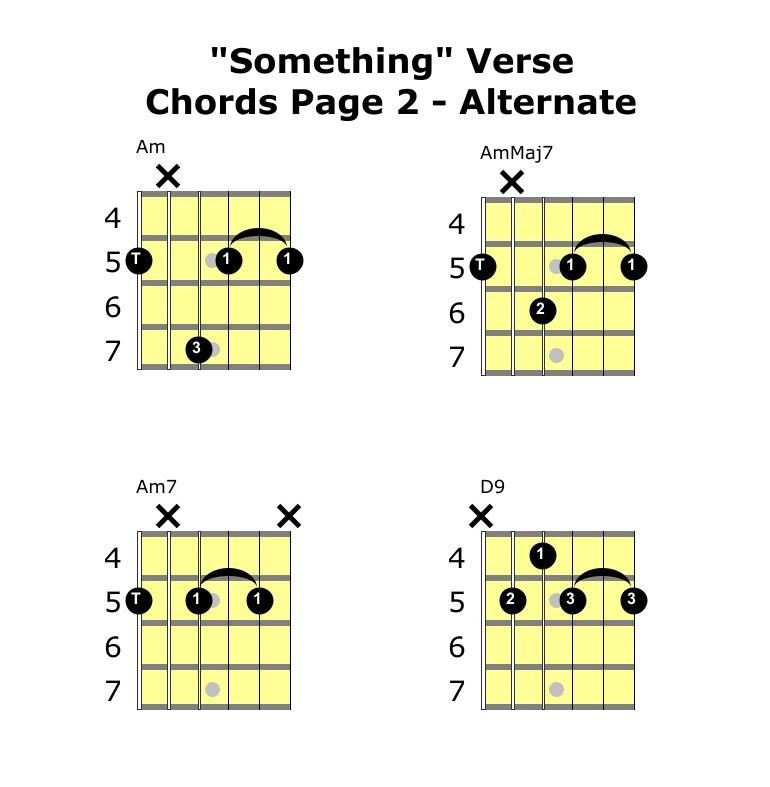 Alternative 5th fret guitar chord diagrams for the verse of "Something" by The Beatles
Alternative 5th fret guitar chord diagrams for the verse of "Something" by The Beatles
Experiment with both sets of voicings to find what feels and sounds best to you.
Chorus Chords
The chorus of “Something” lifts the song to a new emotional height. The chord progression here is both uplifting and slightly melancholic, perfectly capturing the bittersweet nature of the lyrics. Voicing the first four chords on the highest four strings of the guitar adds a bright and ringing quality to this section.
For an added touch of Beatles’ authenticity, you can emulate Paul McCartney’s bassline on guitar during the chorus. This adds a melodic depth that mirrors the original recording. Here’s the bassline transposed for guitar over the A and C chords in bars 15 and 19:
 Bassline transposed to guitar for the chorus of "Something" by The Beatles
Bassline transposed to guitar for the chorus of "Something" by The Beatles
“Something” Chord Progression: A Music Theory Deep Dive
“Something” is celebrated not only for its emotional impact but also for its sophisticated chord progression. George Harrison masterfully employed advanced music theory concepts, making this song a treasure trove for musicians and songwriters. While primarily in C Major, “Something” beautifully incorporates borrowed chords and a modulation in the chorus, adding layers of harmonic richness and depth.
To understand the harmonic landscape, let’s briefly look at the scale of C Major harmonized in triads and four-note chords.
| Degree | I | II | III | IV | V | VI | VII | VIII |
|---|---|---|---|---|---|---|---|---|
| Triad | Major | Minor | Minor | Major | Major | Minor | Diminished | Major |
| 4-Note Chord | Maj7 | Min7 | Min7 | Maj7 | Dom7 | Min7 | m7b5 | Maj7 |
Intro Chord Analysis
The intro immediately sets a sophisticated harmonic tone. Starting on F (IV chord in C Major) is conventional, but the move to Eb is where the harmonic color truly emerges. Eb is borrowed from the parallel minor key of C Minor, adding a touch of bluesy flavor and unexpectedness. The G7, with its 5th (D) in the bass, acts as a dominant chord, creating a perfect cadence back to C, which arrives at the beginning of the verse. The descending bassline (F-Eb-D-C) further enhances the smooth and natural feel of this progression.
Verse Chord Analysis
The verse begins firmly in C Major (chord I), but Harrison quickly introduces chromatic embellishment. The sequence of C, Cmaj7, and C7 over three bars showcases this technique beautifully. The C chord remains the harmonic foundation, while a single note within the chord moves chromatically each bar. In this case, the octave C in the bass descends by semitones (C-B-Bb), creating Cmaj7 and C7 chords, respectively. This technique, also heard in songs like Stevie Wonder’s “I Just Called To Say I Love You,” adds subtle harmonic movement over a static root.
The C7 chord, not diatonic to C Major, functions as the dominant chord of F (chord IV), setting up another perfect cadence in bar 4. The progression then moves to C/E, placing the 3rd of C in the bass, creating a descending bassline (F-E-D) leading into bar 5.
Bars 5 and 6 feature D and D7, also outside of C Major. These chords create a V-I cadence in G Major (D being V of G), leading to the G chord in bar 6. This brief shift towards G adds harmonic interest before returning to the relative minor of C, A minor, in bar 8.
The A minor section mirrors the chromatic embellishment from the C section. The progression Am-AmMaj7-Am7 showcases the same descending chromatic movement, this time within the Am chord. The A octave descends (A-G#-G) creating AmMaj7 (borrowed from A harmonic minor) and Am7. This progression is a classic, found in tunes like “My Funny Valentine” and even “Stairway To Heaven,” demonstrating its timeless appeal. The Am7 then resolves to D9 in bar 9, with the bass note descending to F#, creating a smooth transition.
Chorus Chord Analysis
The chorus of “Something” brings a significant harmonic shift – a modulation to the key of A Major. This key change, a major third up from C, is uplifting and creates a sense of emotional expansion. A Major is the relative major of C minor, which is closely related to C Major, making the modulation sound natural and pleasing.
The chorus begins on A Major (chord I in A Major), then moves to Amaj7 with a G# in the bass, creating a descending bassline (A-G#-F#m). The F#m chord is chord VI in A Major. The progression then briefly shifts down a whole tone to G Major, featuring G (I in G Major) and D (V in G Major) chords, before returning to A Major. On the second chorus, the song modulates back to the original key of C Major, creating a satisfying resolution.
“Something” Guitar Solo Tab: Master George Harrison’s Iconic Solo
George Harrison’s guitar work on “Something” is nothing short of iconic. His solo is melodic, perfectly crafted, and deeply connected to the song’s harmonic structure. Here, we provide you with the guitar tab for both the intro lick and the complete guitar solo. Understanding these tabs is your gateway to playing these legendary parts yourself.
Let’s start with the intro lick, a short but incredibly effective melodic hook that introduces the song. Harrison masterfully uses chord tones in this lick, making it sound both sophisticated and instantly memorable.
Part of the intro’s brilliance lies in Harrison’s note choices. He begins by playing the 3rd of F (A), then bends up to the 5th (C). Over the Eb chord, he emphasizes the 5th (Bb), moving up a semitone to B (the 3rd of Eb), and finally resolving to C, the root note of the implied C chord that follows. This chromatic approach is masterful in its simplicity and effectiveness.
Now, let’s dive into the full guitar solo, a masterclass in melodic soloing.
Guitar Solo Tab
Below is the transcription of George Harrison’s unforgettable guitar solo from “Something.”
 Guitar solo tab for "Something" by The Beatles, played by George Harrison
Guitar solo tab for "Something" by The Beatles, played by George Harrison
Analyzing George Harrison’s Solo: Note Choices and Techniques
What makes George Harrison’s solo in “Something” so exceptional? A key element is his consistent use of chord tones. Harrison has a remarkable ability to land on the “right” notes at the “right” time, creating phrases that are both melodic and harmonically rich.
To illustrate this, let’s examine the chords in the verse progression and the notes that make them up:
| Chord | Notes (Root, 3rd, 5th, etc.) |
|---|---|
| C | C E G (R, 3rd, 5th) |
| CMaj7 | C E G B (R, 3rd, 5th, 7th) |
| C7 | C E G Bb (R, 3rd, 5th, b7th) |
| F | F A C |
| C/E | E G C (3rd, 5th, Root) |
| D | D F# A (R, 3rd, 5th) |
| D7 | D F# A C (R, 3rd, 5th, b7th) |
| G | G B D (R, 3rd, 5th) |
| Am | A C E (R, b3rd, 5th) |
| AmMaj7 | A C E G# (R, b3rd, 5th, Maj7) |
| Am7 | A C E G (R, b3rd, 5th, b7th) |
| D9 | D F# A C E (R, 3rd, 5th, b7th, 9th) |
By understanding these chord tones, we can better appreciate Harrison’s soloing approach. In the analyzed tab below, each interval is labeled in relation to the chord being played over, providing a clear picture of his note choices.
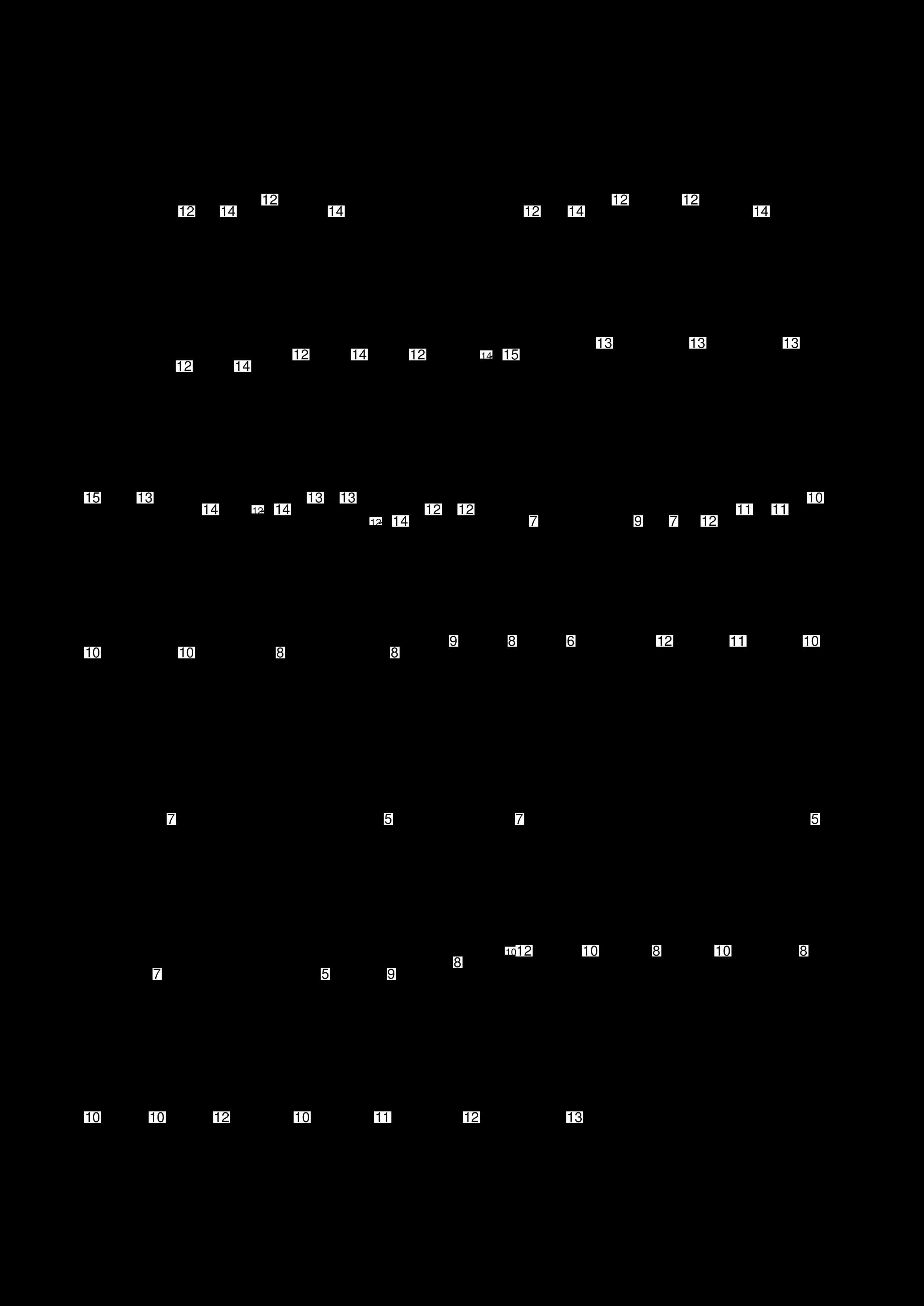 Guitar solo tab analysis for "Something" by George Harrison, highlighting interval choices
Guitar solo tab analysis for "Something" by George Harrison, highlighting interval choices
As you can see, Harrison frequently targets chord tones, especially 3rds and 5ths. These are strong melodic choices that outline the harmony effectively. While landing on the root note can sometimes sound too predictable, emphasizing 3rds and 5ths creates a more nuanced and melodic solo.
Notice the “outside” notes Harrison plays over the G chord in bar 6. This phrase is harmonically adventurous, incorporating altered notes like b5s and b13s. This jazz-influenced lick, possibly inspired by Django Reinhardt, creates tension before resolving beautifully with the bending lick in bar 7. This unexpected note choice adds a layer of sophistication and melodic interest to the solo.
Final Thoughts
Learning “Something” by The Beatles is a rewarding journey for any guitarist. Its intricate chord progression, combined with George Harrison’s melodic guitar solo, makes it a song that is both challenging and deeply satisfying to play. We hope this guitar lesson and music theory analysis has provided you with the tools and insights to master this masterpiece. By studying “Something,” you can gain valuable concepts to apply to your own songwriting and improvisational guitar playing. The Beatles continue to inspire generations of musicians, and “Something” remains a shining example of their timeless genius.
Keep practicing, explore more Beatles songs, and continue your musical journey!
